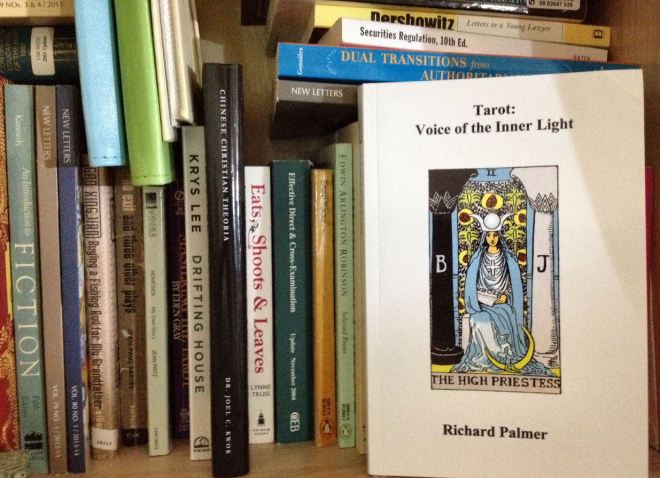
I’ve got a new amazing addition to my personal library: Richard Palmer’s Tarot: Voice of the Inner Light (Custom Book Publishing, 2008). If this book had existed in the 90s, I would have advanced in my tarot practice so much faster. When I started out in tarot, there weren’t limitless online references and glossaries on card meanings, which by the way I still do not find all that useful, as much of it is the blind leading the blind, with no indication of the source of the card meanings provided or no identification of the tradition used.
(Oh and please do not mind the unorganized bookshelf. Hubby and I are preparing to move to a new house, so I figured I’d wait until we settled in to organize a library. Right now I have literary fiction next to books on law next to classical poetry next to Christian theology next to Buddhist philosophy next to my little collection of stuff on the esoteric and the occult. Anyway.)
The first lines of the Introduction tells you exactly what you’ll get: “There are many complex and profound books written on the subject of the Tarot. This isn’t one of them. The aim of this work is to bring the practical knowledge of how to use the Tarot into the life of anyone who is willing to put forth the minimum effort necessary to understand this remarkable gift.” Voice of the Inner Light is give or take a 240 page reference book, about 60,000 words if I had to guestimate. In essentially 10 pages upfront, the book teaches you how to begin using your tarot deck. There is no longwinded research on history, origins, philosophy, or theosophy. I understand that most advanced practitioners are looking for theory, but this book is not targeted at that kind of reader. This book is targeted at that starting practitioner who may have read 1 or 2 more comprehensive books on tarot and is now looking for a go-to reference manual to keep on the desk for readings.
Per my own analysis of Palmer’s book, his card meaning interpretations are based heavily on Hermetic Qabalah. Palmer is also a renowned astrologer, and so Voice of the Inner Light is going to be indispensable to tarot practitioners who integrate Western astrology with tarot.
Each card is covered in 2-3 pages. A card description and key symbolism is provided, then the card’s astrological association, and then the practical application of the card when upright and when reversed. Then a concluding remark is offered on Qabalistic correspondences. Such concise coverage of card meanings is the primary purpose of the book. Other than how to read a single card or perform a simple 3-card reading, Voice of the Inner Light is not for teaching spreads or how to intuitively read multi-card spreads. The book’s purpose is for the foundational understanding of each and every card.
Thus, I consider it an intermediate reference manual. If you have read a few beginner books on tarot, this book is a useful supplemental next step. However, for advanced practitioners who want to begin building a repertoire of spreads and how to use the tarot in complex reading techniques, this won’t be the right book for that. Voice of the Inner Light will be an integral supplement to such goals. As you learn complex reading techniques, you will need a book that provides in-depth interpretation of each card, in which case Voice is one of the best. Also, those with a particular leaning for the GD interpretive method, Voice will be highly appealing as opposed to the more what I call New-Agey-keyed reference manuals.

Yes, I am very excited by this post, by the read of it. This is exactly what I am looking for! I’m going to be buying this book the second i pay my other bills first! Thank you so much for sharing!
– xox Tempest
LikeLike
Here it is on Amazon: http://www.amazon.com/Tarot-Voice-The-Inner-Light/dp/1438269102/ref=sr_1_1?ie=UTF8&qid=1389672360&sr=8-1&keywords=Voice+of+the+Inner+Light+Palmer
Good luck! =)
LikeLike
Thank you 🙂
LikeLike
Pingback: A Tarot Reader Guest Blogs at Best American Poetry | Benebell Wen
I go to see daily a few web sites and websites to read articles, but this web site presents quality based articles.
LikeLike